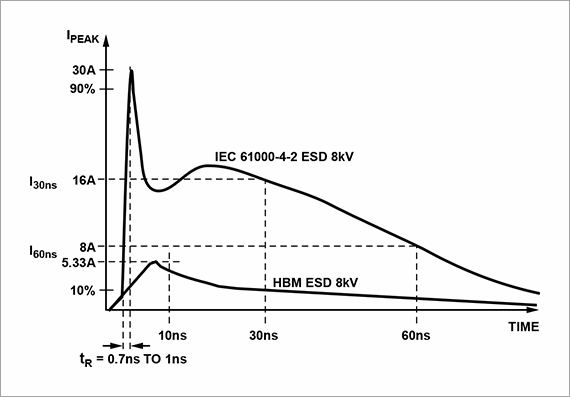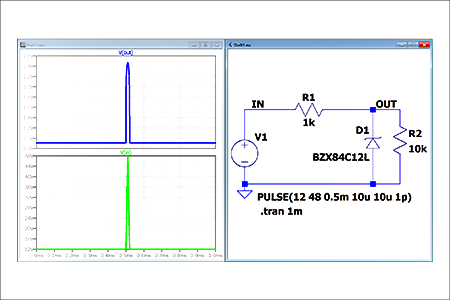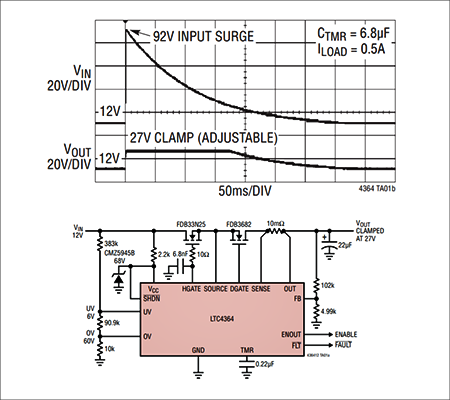デバイスを壊してしまう主な原因は、デバイスの規定範囲外の電圧を印加してしまうことです。
市場に出荷しているシステムの信頼性の面から、過電圧によるデバイスの破壊が発生しないように回路上では、保護デバイスになどによる対策を実施することが重要です。
静電気による破壊を対策するには

静電気によるESD破壊は、過電圧破壊のひとつと考えられます。
静電気の場合、短時間(1ns以下)に非常に高い電圧が印加されますので、ESD対策用の保護素子としてESDサプレッサー/ TVSダイオードが必要となります。例えば、ウルトエレトロニクス社のESD対策用保護素子(こちらから購入可能)を使うことで対策できます。
インターフェース関係は、筐体の外に金属で露出するため特にESDの対策が重要となります。アナログ・デバイセズ社では、インターフェース製品についてESD対策を強化した製品を開発しIEC 61000-4-2のレベル3規格に対応している製品もあります。
詳細は、ESD対策を強化したRS485デバイス ADM3065Eを参照ください。
ノイズによる過電圧破壊

ノイズによる過電圧破壊は、電源ソースのノイズや装置間・基板間で発生したノイズが電源ラインや通信線を伝搬してデバイスを破壊します。
スイッチのオン・オフやホットな状態で基板・ケーブルの抜き差しにより過電圧ノイズが発生する可能性があります。これらの過電圧ノイズの対策にはツェナーダイオードのブレイクダウン電圧を利用して、過電圧をクランプします。 オンセミ社のツェナーダイオードは、こちら。
右図は、オンセミ社のツェナーダイオード (BZX84C12L)に、48Vの過電圧ノイズを印加した際のクランプ特性でLTspiceを用いてシミュレーション結果です。下の図が入力で過電圧の48Vが入力されていることが分かります。上の図がツェナーで48Vの過電圧ノイズがクランプされて12.5Vになっているシミュレーション結果です。
誘導性負荷やインダクタンスによる過電圧発生
電源が長いケーブルで接続する必要があるシステムの場合、ケーブルのインダクタンス成分により電源投入時に1msec以上の過電圧が発生する可能性があります。
このような条件においては、ノイズ対策で入れているツェナーダイオードでは想定以上の消費電力となり許容電力を超えてしまう可能性があります。そのような場合には、高耐圧の電源ICやモジュールを電源と回路の間に入れることで、回路に安定的な電源供給をおこなう必要があります。
ただし、電源ICやモジュールの場合、安定した電圧を出力するレギュレーションの機能が求められるため、対応できる動作電圧範囲に限界があります。このような条件がそろうアプリケーションとしては、産業機器向けに作られたカメラやセンサーモジュール、車載機器などが考えられます。
過電圧保護ソリューション「サージストッパー」
TVSやツェナーダイオードで保護が難しい、1msec以上の過電圧が発生するような場合の対策方法として、アナログ・デバイセズ社が開発したサージストッパー製品により対策が可能です。
「サージストッパー」製品の内容に入る前に、「サージ (Surge) 」という単語について調べてみました。すると、「うねり」や「大波」という意味であることがわかりました。なんとなく、サージ=静電気やノイズというイメージがあり、何故1msec以上の過電圧なのか疑問でしたが、「うねり」と言う意味であれば、1msec以上の過電圧を止めるソリューションであることに納得しました。
MILスタンダードの規定 (MIL-STD-1275D) は、次のように規定しています。サージとして、500msecの過電圧に対応することが要求されていることがわかります。
| 仕様 | 通常動作モード | ジェネレーターのみモード |
|---|---|---|
| 定常状態 | 25V < VIN < 30V | 23V < VIN < 33V |
| スパイク | 最大250V エネルギー = 15mJ |
通常動作モードと同じ |
| サージ | 最大40V, 約500ms, RSOURCE = 20mΩ |
最大100V, 約500ms, RSOURCE = 500mΩ |
| リップル | 大きさ±2V | 大きさ±7V |
MILスタンダードの規定(MIL-STD-1275D)

右図は、サージストッパー製品LTC4364の回路図と92Vのサージを印加した時の波形になります。
12Vラインにサージ電圧が入力された場合、LTC4364がFET (FDB33N25) を制御することで、分圧抵抗で設定した電圧にクランプにします。右図の波形では、サージ電圧92Vを27Vにクランプしています。入力がクランプ設定電圧の27Vよりも下がってくると入力に合わせて出力も低下します。
それでは、サージストッパー製品についての詳細説明とデモの動画をご覧ください。
サージストッパー製品の説明とデモ動画(動画時間:約7分)
おすすめ記事/資料はこちら
おすすめセミナー/ワークショップはこちら
お問い合わせ
アナログデバイセズ製品について、ご質問等がある場合はこちらからお問い合わせください。
アナログ・デバイセズ メーカー情報Topへ
アナログ・デバイセズ メーカー情報Topページへ戻りたい方は、以下をクリックください。
